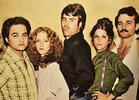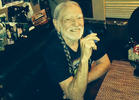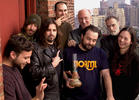
While hardcore Deadheads massed in Chicago for the supposed final Grateful Dead shows at Soldier Field this past weekend, the rest of us were home taking in the concerts via simulcast and Sirius radio. A Deadhead is a Deadhead, no matter where you are.
For me, it all started on Aug. 26, 1971 at Gaelic Park in my home borough of the Bronx, NY. For one brief summer the Irish football stadium in the shadow of Manhattan College was turned into a concert venue. I grew up in Riverdale, a short walk "down the hill" to Gaelic Park. I don't remember much about the show, but based on the set list, it was a pretty good one, especially the second set which opened with "China Cat Sunflower/I Know You Rider" and continued with "Truckin'," "The Other One," "St. Stephen" and a "Not Fade Away" finale. That'll hook you for life.
After my first year at Lehman College (also in the Bronx), I criss-crossed the country with Ed Bender, ending up in Berkeley. Walking down Telegraph Ave. on Aug. 24, 1972, we saw a sign for a Grateful Dead show that night at the local Community Theatre. Back then tickets were easy to score. We paid $10 each at the ticket window and were treated to another show with "China Cat/Rider" and this time a "Dark Star > "Morning Dew."

When it came time to give and receive holidays gifts in December, I unwrapped the three-disc Europe '72 set. Along with Workingman's Dead and American Beauty that preceded it, they remain my favorite Grateful Dead albums. I always thought the spelling of Aoxomoxoa was cool, but had a hard time getting into the group's psychedelic weirdness. With Workingmen's Dead and American Beauty, the band had transitioned into what would these days be called "Americana" - a loose mix of country rock, blues and psychedelia.
I saw them again at Nassau Coliseum in Uniondale, NY in 1973, but I'm not quite sure what date that was - they played there in March and September. But I remember this as the best of my first three shows. The band really cooked and played most of songs from Europe '72.
I didn't follow the Dead as much during the mid-'70s and through their hiatus. In either January or September of 1979 I caught them at Madison Square Garden. I recall that show as a marked decline from the earlier ones. They had slowed down considerably. I attributed that to Jerry Garcia's heroin use.
A Deadhead is a Deadhead, no matter where you are.
A decade later, I'd started working at High Times. Though the magazine had a hippie reputation, no one seemed to care much about the Dead when I got there, so I assigned myself the Dead beat. By then the band had been touring for years followed by a large contingent of Deadheads. This led to police and security issues at shows, mostly in the sprawling parking lots, where Shakedown Street bazaars popped up. A young fan named Adam Katz was killed during a show at the then-named Giants Stadium in New Jersey and another died at an L.A. show. I began covering the Deadheads as a news story because they were being targeted by narcs in the parking lots.
I went to a very tense show on Mar. 15, 1989. Cops on horses were all over the lot. But inside, fans were having a blast, spinning and twirling to "China Cat/Rider" and the lengthy "Terrapin Station."
As the weekend wore on, Trey Anastasio made a strong case that he's the best Garcia stand-in ever.
Ed Bender and I reunited to attend several shows in the early '90s, including great ones with overnight parking lot scenes at Buckeye Lake in Ohio and Foxboro in Massachusetts, and the 1990 New Year's run at the Oakland Coliseum, where I discovered 420.
By 1995, things were not going so well. Garcia was forgetting lyrics and fans crashed the party at Deer Creek on July 2, leading the band to issue their infamous "The Darkness Has Got to Give" statement ("If you don't have a ticket, don't come"). Just two weeks before, they'd returned to Giants Stadium for several shows. I was there. It would be my last Dead show with Garcia alive and still barely kicking. He died on Aug. 9, 1995.

I wrote the cover story about Jerry for High Times. Unfortunately, that story is not posted at hightimes.com and my copies of the magazine are in storage, so I can't glance back at what I wrote. The Dead were never very friendly to High Times; I wasn't granted interviews, much less tickets. I did, however, get to ask Bob Weir a question about the LSD arrests at Dead shows when the band was inducted into the Rock & Roll Hall of Fame in 1994. (He said it should be legal.)
Since Jerry's death, I've been to numerous Further, Phil Lesh and Friends, and Bob Weir and Ratdog shows. They're basically tribute concerts with various guitarists filling in for Garica. The latest substitute is Phish frontman Trey Anastasio, who was drafted to join the "Core Four" (Weir, Lesh, and drummers Mickey Hart and Bill Kreutzmnann) for the band's Fare Thee Well swan song. As one of the Deadheads who gravitated to Phish, I've been awed by Anastasio's guitar chops at many Phish shows. He was the natural choice for this important occasion.
I attended the simulcast on July 3 at the Capitol Theatre in Port Chester, which is ground zero for New York-area Deadheads. (The venue is owned by Peter Shaprio, who along with Madison House Presents, is promoting Fare Thee Well.) I'd watched a lot of clips from the previous weekend's shows in Santa Clara. Like most observers noted, it seemed that Anastasio was being underused. He only took a few lead vocals and his playing felt somewhat tentative. But in the first Chicago show, Anastasio had a break-out game, as they say in sports. Combining his muscular style with Garcia's nimble picking, Trey finally felt at home during the second set, when he stretched out on the rollicking medley, "Help on the Way/Slipknot/Franklin's Tower ("roll away the dew!"). As the weekend wore on, the band came together as a formidable unit, with Anastasio making a strong case that he's the best Garcia stand-in ever.
Will this be there the last hurrah for the Dead? I doubt it. When I interviewed Bob Weir for Billboard in January, he told me in answer to that question: "We’ll see. I’ve got some miles left in me, but I’m sure everybody does. I'm the youngest of the guys."
So we'll have to wait and see, like Weir says, to find out if the Grateful Dead's long, strange trip is truly over.






